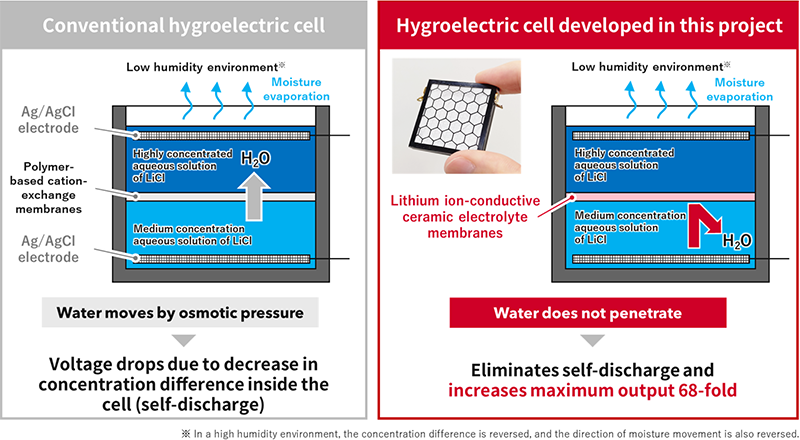Researchers) KOMAZAKI Yusuke, Senior Researcher, NOBESHIMA Taiki, Senior Researcher, HIRAMA Hirotada Senior Researcher, Human Augmentation Research Center, WATANABE Yuichi Senior Researcher, SUEMORI Kouji, Senior Researcher, UEMURA Sei, Director, Research Center, Sensing System Research Center
- Improved hygroelectric cell utilizing day–night humidity cycles to power electronic circuits
- Advancing toward practical application as a clean power source that can stably supply power even in dark places
- Derived a thermodynamic theory of power generation using humidity changes, and theoretically demonstrated that a quasi-static cycle can generate power with 100% efficiency

Overview of high-power output of hygroelectric cells with ceramic solid electrolyte membranes Figures from the original paper have been cited and modified.
*Figure modified from Komazaki et al., Advanced Energy and Sustainability Research, 6, 2400342 (2025).
In fields such as infrastructure development and agriculture, there are high expectations for smarter monitoring using IoT technology and sensors, but securing a power source for sensors installed onsite has been a challenge. Dry cell batteries, for example, need to be replaced periodically, and solar cells are not suitable for dark locations. On the other hand, hygroelectric cells generate power using day/night humidity changes, so they can be used anywhere, and are expected to be used as a power source for small wireless sensors.
Researchers at AIST have developed a hygroelectric cell with increased power output to the point where it can drive electronic circuits, making it the first in the world to successfully power a wireless sensor for more than four months by generating electricity using humidity changes.
Since hygroelectric cells generate power using day/night humidity changes, they can generate power anywhere, except in environments with constant humidity, and are expected to be used as a new energy harvesting technology for power sources for small wireless sensors and other devices. Until now, power generation output has been low, not enough to drive electronic circuits. However, the output has now been improved using ceramic solid electrolyte membranes, and small wireless sensors have been successfully powered for more than four months. This is expected to make it possible to use maintenance-free wireless sensors without the need for battery replacement even in dark places where solar cells cannot be used, such as under bridges and in machine control panels.
We have also derived a thermodynamic theory of power generation using humidity change, and theoretically clarified that the hygroelectric cell we have developed is capable of generating electricity with 100% efficiency in a quasi-static cycle. This theory is expected to be utilized to further develop research for improving the performance of hygroelectric cells.
Journal: Advanced Energy & Sustainability Research
Title of paper: Hygroelectric Energy Harvesting by Daily Humidity Cycles and Its Thermodynamics
Authors: Yusuke Komazaki, Taiki Nobeshima, Hirotada Hirama, Yuichi Watanabe, Kouji Suemori and Sei Uemura
DOI: https://doi.org/10.1002/aesr.202400342